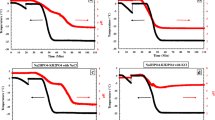Abstract
Purpose. To evaluate crystallization behavior and collapse temperature (Tg') of buffers in the frozen state, in view of its importance in the development of lyophilized formulations.
Methods. Sodium tartrate, sodium malate, potassium citrate, and sodium citrate buffers were prepared with a pH range within their individual buffering capacities. Crystallization and the Tg’ were detected during heating of the frozen solutions using standard DSC and modulated DSC.
Results. Citrate and malate did not exhibit crystallization, while succinate and tartrate crystallized during heating of the frozen solutions. The citrate buffer had a higher Tg’ than malate and tartrate buffers at the same pH. Tg’ vs. pH graphs for citrate and malate buffers studied had a similar shape, with a maximum in Tg’ at pH ranging from 3 to 4. The Tg’ maximum was explained as a result of a competition between two opposing trends: an increase in the viscosity of the amorphous phase because of an increase in electrostatic interaction, and a decrease in the Tg’ because of an increase in a water concentration of the freeze-concentrated solution.
Conclusion. Citrate buffer was identified as the preferred buffer for lyophilized pharmaceuticals because of its higher Tg’ and a lower crystallization tendency.
Similar content being viewed by others
REFERENCES
G. Flynn. Buffers-pH Control within Pharmaceutical Systems. J. Parenteral Drug Assoc. 34:139–162 (1980).
L van den Berg. pH changes in buffers and foods during freezing and subsequent storage. Cryobiology 3:236–242 (1966).
L. Van Den Berg and D. Rose. The effect of addition of sodium and potassium chloride to the reciprocal system: KH2PO4-Na2HPO4-H2O on pH and composition during freezing. Arch. Biochim. Biophys. 84:305–315 (1959).
L. Van Den Berg and D. Rose. Effects of freezing on the pH and composition if sodium and potassium solutions: reciprocal system KH2PO4-Na2HPO4-NaH2PO4-H2O. Arch. Biochim. Biophys. 81:319–329 (1959).
G. Gomez, M.J. Pikal, and N. Rodriguez-Hornedo. Effect of initial buffer composition on pH changes during far-from-equilibrium freezing of sodium phosphate buffer solutions. Pharm. Res. 18:90–97 (2001).
T.J. Anchordoquy and J.F. Carpenter. Polymers protect lactate dehydrogenase during freeze-drying by inhibiting dissociation in the frozen state. Arch. Biochim. Biophys. 332:231–238 (1996).
R.K. Cavatur and R. Suryanarayanan. Characterization of frozen aqueous solutions by low temperature X-ray powder diffractometry. Pharm. Res. 15:194–199 (1998).
L. van den Berg. Changes in pH of milk during freezing and frozen storage. J. Dairy Sci. 14:26–31 (1961).
S.S. Larsen. Studies on stability of drugs in frozen systems. VI. The effect of freezing on pH for buffered aqueous solutions. Arch. Pharm. Chemi Sci. Ed. 1:41–53 (1973).
Y. Orii and M. Morita. Measurement of the pH of frozen buffer solutions by using pH indicators. J. Biochem. 81:163–168 (1977).
B.S. Chang and C.S. Randall. Use of subambient thermal analysis to optimize protein lyophilization. Cryobiology 29:632–656 (1992).
N. Murase and F. Franks. Salt precipitation during the freeze-concentration of phosphate buffer solutions. Biophys. Chem. 34:293–300 (1989).
J.F. Carpenter, M.J. Pikal, B.S. Chang, and T.W. Randolph. Rational design of stable lyophilized protein formulations: Some practical Advice. Pharm. Res. 14:969–975 (1997).
M.J. Akers, N. Milton, S.R. Byrn, and S.L. Nail. Glycine crystallization during freezing: the effects of salt form, pH, and ionic strength. Pharm. Res. 12:1457–1461 (1995).
M.J. Pikal and S. Shah. The collapse temperature in freeze-drying: Dependence on measurement methodology and rate of water removal from the glassy phase. Intern. J. Pharm. 62:165–186 (1990).
L-M. Her, M. Deras, and S.L. Nail. Electrolyte-induced changes in glass transition temperatures of freeze-concentrated solutes. Pharm. Res. 12:768–772 (1995).
H. Levine and L. Slade. Thermomechanical properties of small carbohydrate-water glasses and "rubbers": Kinetically metastable systems at sub-zero temperatures. J. Chem. Soc. Faraday Trans. 1 84:2619–2633 (1988).
S.R. Aubuchon, L.C. Thomas, and H. Renner. Investigations of the sub-ambient transitions in frozen sucrose by modulated differential scanning calorimetry (MDSC). J. Therm. Anal. Calorim. 52:53–64 (1998).
E.Y. Shalaev and F. Franks. Structural glass transition and thermophysical processes in amorphous carbohydrates and their supersaturated solutions. J. Chem. Soc. Faraday Trans. 91:1511–1517 (1995).
Y. Roos and M. Karel. Nonequilibrium ice formation in carbohydrate solutions. Cryo-Letters 12:367–376 (1991).
A.B. Andersen and L.H. Skibsted. Glass transition of freeze-concentrated aqueous solution of ascorbic acid as studied by alternating differential scanning calorimetry. Lbensm.-Wiss. u.-Technol. 31:69–73 (1998).
T. Moreira. Thesis, University of Dijon, France (1976). Citation from: E. Maltini and N.M. Anese. Evaluation of viscosities of amorphous phases in partially frozen systems by WLF kinetics and glass transition temperatures. Food Res. Int. 28: 367–372 (1995).
Q. Lu and G. Zografi. Properties of citric acid at the glass transition. J. Pharm. Sci. 86:1374–1378 (1997).
T. Osterberg and T. Wadsten. Physical state of L-histidine after freeze-drying and long-term storage. Europ. J. Pharm. Sci. 8:301–308 (1999).
E.Y. Shalaev, F. Franks, and P. Echlin. Crystalline and amorphous phases in the ternary system water-sucrose-sodium chloride. J. Phys. Chem. 100:1144–1152 (1996).
P. Tong and G. Zografi. Solid-state characteristics of amorphous sodium indomethacin relative to its free acid. Pharm. Res. 16:1186–1192 (1999).
E.C. To and J.M. Flink. "Collapse", a structural transition in freeze dried carbohydrates. II. Effect of solute composition. J. Fd Technol. 13:567–581 (1978).
E.Y. Shalaev and F. Franks. Changes in the physical state of model mixtures during freezing and drying: impact on product quality. Cryobiology 33:14–26 (1996).
Author information
Authors and Affiliations
Corresponding author
Rights and permissions
About this article
Cite this article
Shalaev, E.Y., Johnson-Elton, T.D., Chang, L. et al. Thermophysical Properties of Pharmaceutically Compatible Buffers at Sub-Zero Temperatures: Implications for Freeze-Drying. Pharm Res 19, 195–201 (2002). https://doi.org/10.1023/A:1014229001433
Issue Date:
DOI: https://doi.org/10.1023/A:1014229001433




